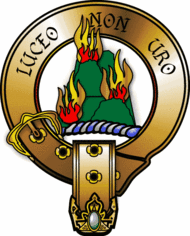| Clan Mackenzie | |||
|---|---|---|---|
| Clann Choinnich[1] | |||
 | |||
| Motto | Luceo non uro (I shine not burn)[2] | ||
| Slogan | Tulach Àrd (The high hill or The high knoll or "The high hillock) | ||
| Profile | |||
| Region | Highland | ||
| District | Ross-shire | ||
| Plant badge | variegated holly or deergrass | ||
| Chief | |||
 | |||
| John Ruaridh Grant Mackenzie | |||
| 5th Earl of Cromartie (Caber Feidh[3]) | |||
| Seat | Castle Leod[4] | ||
| Historic seat | Eilean Donan Castle Redcastle | ||
| |||
| |||
| |||
| |||
Clan Mackenzie (Scottish Gaelic: Clann MacCoinnich [ˈkʰl̪ˠãũn̪ˠ max'kɤNʲiç]) is a Scottish clan, traditionally associated with Kintail and lands in Ross-shire in the Scottish Highlands. Traditional genealogies trace the ancestors of the Mackenzie chiefs to the 12th century. However, the earliest Mackenzie chief recorded by contemporary evidence is Alexander Mackenzie of Kintail who died some time after 1471. Traditionally, during the Wars of Scottish Independence, the Mackenzies supported Robert the Bruce, but feuded with the Earls of Ross in the latter part of the 14th century. During the 15th and 16th-centuries the Mackenzies feuded with the neighboring clans of Munro and MacDonald. In the 17th century the Mackenzie chief was made Earl of Seaforth in the peerage of Scotland. During the Scottish Civil War of the 17th century the Mackenzies largely supported the Royalists. During the Jacobite rising of 1715 the chief and clan of Mackenzie supported the Jacobite cause. However, during the Jacobite rising of 1745 the clan was divided with the chief, Kenneth Mackenzie, Lord Fortrose, supporting the British-Hanoverian Government and his relative, George Mackenzie, 3rd Earl of Cromartie, supporting the Jacobites.
- ^ Mac an Tàilleir, Iain. "Ainmean Pearsanta" (docx). Sabhal Mòr Ostaig. Archived from the original on 17 July 2011. Retrieved 15 October 2009.
- ^ a b Cite error: The named reference
clan-mackenzie.org.ukwas invoked but never defined (see the help page). - ^ Fairrie, Angus (1998). Queen's Own Highlanders, Seaforth and Camerons. Northern Times. p. 2. ISBN 0-9508986-2-7.
- ^ Coventry, Martin (2008). Castles of the Clans: The Strongholds and Seats of 750 Scottish Families and Clans. Musselburgh: Goblinshead. pp. 377–380. ISBN 978-1-899874-36-1.
- ^ a b c d e f g h i j k l m n o p q r s t u v w x y z aa ab ac ad ae af ag ah ai aj ak al am an ao ap "Clan Mackenzie Septs". clanmackenziesociety.co.uk. Retrieved 17 November 2019.
- ^ Thomas, F.W.L. (1879–1880). "Traditions of the Macaulays of Lewis" (PDF). Proceedings of the Society of Antiquaries of Scotland. 14: 383–384. Archived from the original (PDF) on 11 June 2007.